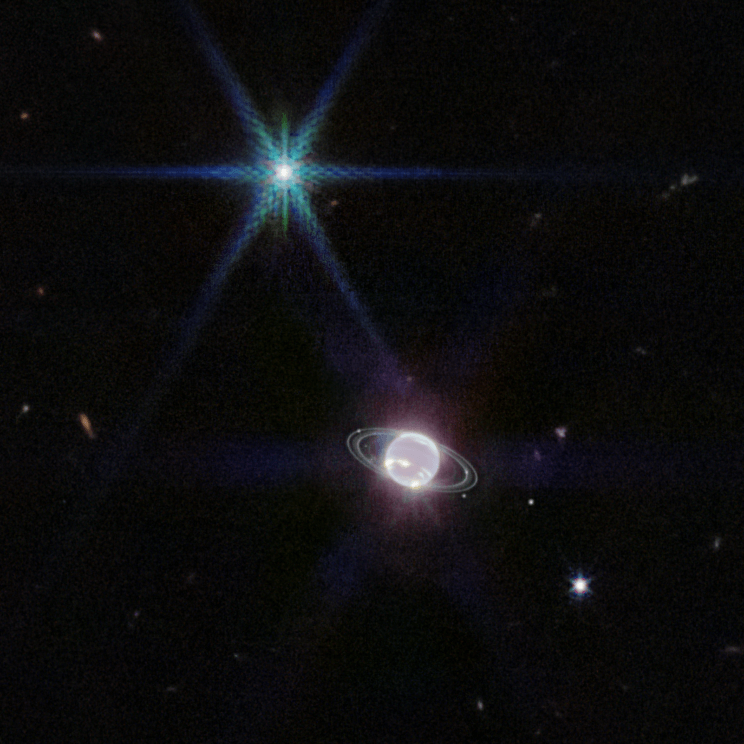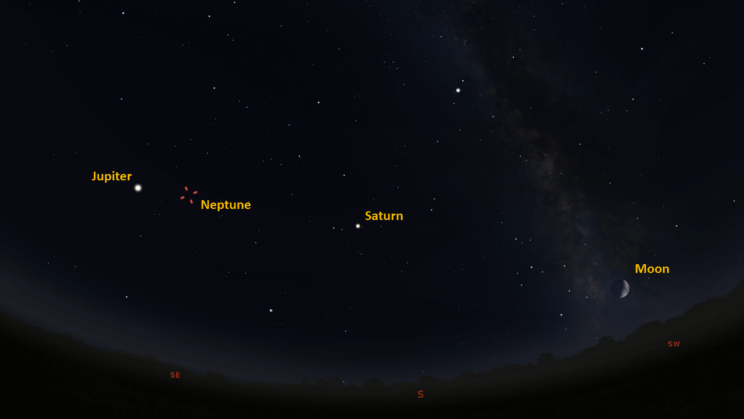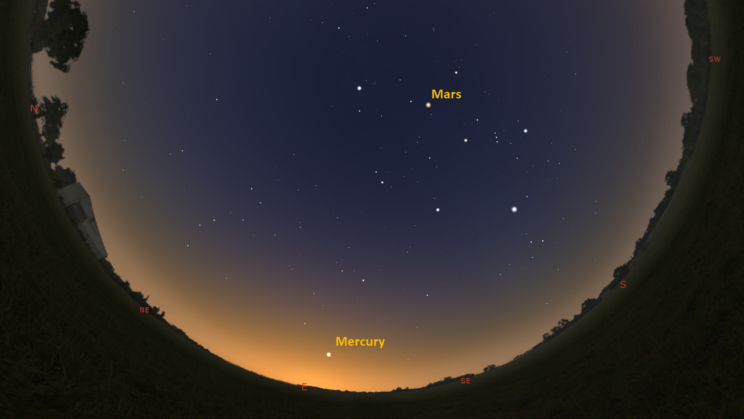This is the Saint Louis Science Center’s NIGHT SKY UPDATE for the week of Friday, September 30, 2022.
Information updated weekly or as needed.
Times given as local St. Louis time which is Central Daylight Time (CDT). For definitions of terminology used in the night sky update, click the highlighted text. If relying on times posted in Universal Time (UT), St. louis is -5 hours when CDT.
Public Telescope Viewings
Public telescope viewings at the McDonnell Planetarium have returned as part of the Saint Louis Science Center’s First Friday event. As we ease back into our telescope nights, they will operate a little different than before. To take part in our telescope viewings you will need to get a ticket for the planetarium show that starts at 7:00 p.m. as part of the First Friday event. Tickets for the First Friday planetarium show are free, but they can only be picked up at the Saint Louis Science Center on the night of the event. After the planetarium show ends you will be able to go outside and look through telescopes weather permitting. We will update this posting if anything changes.
Observing Highlight of the Week

JWST image of Neptune, its rings and several moons. The bright object with diffractions lines is Neptune’s moon Triton. Image credit: NASA, ESA, CSA, STScI.
This week there are several objects or events to look forward to. The Moon, several planets and a week meteor shower are a few of this week’s highlights.
The Moon will transition from crescent to gibbous phases this week. First quarter moon occurs on October 2, 2022, making for excellent daytime views in the late afternoon as the week progresses. When at first quarter the Moon will be found in the south as the Sun sets. The Moon will also pass by the planets Saturn, Neptune and Jupiter this week as it shifts through the constellations Scorpius, Ophiuchus, Sagittarius, Capricornus, Aquarius and Pisces.
The Moon will first visit Saturn on October 4/5, 2022. It will appear closer to Saturn on the 5th as the Moon passes through Capricornus. On this night, the Moon will exhibit a waxing gibbous phase with 82% disk illumination.
Next, the Moon will pass by the planet Neptune on October 7, 2022. Neptune will appear roughly 3° north of the Moon. Neptune will be a challenge to spot this night as the Moon will be near its full phase. Neptune will be easier to spot any other night this week by using Jupiter as a guide. Start by looking for Jupiter in binoculars. Once found, scan to the west from Jupiter and you will see a group of stars that look like a hockey stick. These stars are 29 Psc, 27 Psc, 24 Psc and 20 Psc. Once you find these, imagine a line passing from Jupiter through 20 Psc. If you follow this line, it will point you to a 7.2 magnitude star called HIP 116402. If you can spot this star, Neptune is just in front of it appearing as a 7.82 magnitude object. It will be a challenge in modest binoculars, but Neptune should be easy to spot in 10 x 50 binoculars and up. It is recommended to use an astronomy program to learn this star field. I often use Stellarium which is a free desktop planetarium software available for all platforms.
On October 8, 2022, The Moon will be found near Jupiter. Owing to being just past opposition, Jupiter is hard to miss these days. Most should be able to find it without the Moon. But for those still learning to spot planets, the Moon will be a useful aid in spotting Jupiter this night. Several good Great Red Spot (GRE) transits will also occur this week. Jupiter completes an axial rotation in about 10 hours. Because of this, most nights will have a decent transit of the GRE. Usually, it just depends on if you prefer to observe in the pm or am hours of the night. You can use programs like Stellarium to track down when the GRE will be visible. Another option for those not wanting to use Stellarium, is the Sky and Telescope GRE transit calculator. This website will also have several other useful astronomical tools that can aid in your observing sessions.
Mercury becomes visible this week as it heads towards maximum western elongation on October 8, 2022. Mercury will slowly climb out of the twilight glow in the east before sunrise. By the week’s end, Mercury will appear about 9° above the eastern horizon 30 minutes before sunrise. Those with clear views to the east should be able to spot Mercury over the next week and a half. If you have a telescope, Mercury will reach dichotomy on the same date as maximum elongation. Dichotomy describes when an object appears 50% phased. For the Moon we call this a quarter phase. During a morning apparition, Mercury becomes brighter after dichotomy as it transitions into gibbous phases.
Lastly, there is a meteor shower this week that is active from October 5, 2022, to October 7, 2022, with peak hourly rate occurring on the 6th. This shower is called the October Camelopardalids which was confirmed as a shower in 2005 when an outburst (12 meteors) was recorded by video cameras. Since its discovery, the meteor shower has remained active each year, but it is typically listed as a weak meteor shower with variable activity. Most years, only a handful of meteors are spotted on the peak night. Meteors belonging to this shower should be bright enough to be visually spotted, but this year will be difficult due to the gibbous moon that will be visible on the 6th.
The meteor shower is called the October Camelopardalids because its radiant is in the constellation Camelopardalis. The radiant is found about halfway between the Big Dipper’s bowl and the North Star. With low activity and moonlight expected, this will be a difficult shower to watch. Regardless, tracking this activity each year is important as scientists still do not know the source of this shower. The orbits of these meteors may help scientists track down what deposited them. If you find yourself outside a few hours before dawn on October 6, 2022, you may be able to spot a member of this elusive meteor shower. Keep in mind that other meteor showers will be active in October. If you spot a meteor, trace its path backwards. If it takes you to where the known radiant is, then you likely spotted an October Camelopardalid.
The Sun and Moon

The Moon as seen from the International Space Station, on July 31, 2011.
Credit: NASA
Sunrise is at 6:56 a.m. on Friday, September 30 and sunset is at 6:45 p.m. providing us with a bit under 12 hours of daylight. Even after sunset, the light from the Sun will dimly illuminate our sky for roughly 1 hour and 30 minutes. This period is called twilight, which ends around 8:13 p.m. this week. For those with a sundial, local noon occurs around 12:50 p.m. this week.
| Day | Sunrise | Sunset |
|---|---|---|
| 2022-09-30 | 6:56 a.m. | 6:45 p.m. |
| 2022-10-01 | 6:57 a.m. | 6:43 p.m. |
| 2022-10-02 | 6:58 a.m. | 6:42 p.m. |
| 2022-10-03 | 6:58 a.m. | 6:40 p.m. |
| 2022-10-04 | 6:59 a.m. | 6:39 p.m. |
| 2022-10-05 | 7:00 a.m. | 6:37 p.m. |
| 2022-10-06 | 7:01 a.m. | 6:36 p.m. |
| 2022-10-07 | 7:02 a.m. | 6:34 p.m. |
| 2022-10-08 | 7:03 a.m. | 6:33 p.m. |
Moon
Moonrise for Friday, September 30 occurred at 1:19 a.m. and moonset occurs at 10:30 p.m. Friday, September 30, the Moon will exhibit a waning crescent phase with 35% of the lunar disk illuminated. First quarter moon occurs on October 2, 2022, at 7:14 p.m.
International Space Station (ISS) Observing

Visible passes of ISS from St. Louis for the week of September 30 occur during evening hours. The best passes this week occur on October 2, 3 and 6. Use the table below for information about these and other visible passes this week.
Blue Walker 3
A new satellite called BlueWalker 3, has successfully been deployed in low Earth orbit. This is a test satellite from AST SpaceMobile that is intended to supply 4G cell phone signals from space. This test unit spans 64 square meters. Future plans if successful, are to launch over 100 larger satellites called BlueBirds. Their intention is to provide better global cell coverage. The scientific community has expressed concerns over the impact they will have on astronomical research. Due to their size these satellites will likely become one of the brightest objects visible at night producing a space-based form of light pollution.
Visible passes of this large satellite are starting this week. Poke your heads outside and see if you can spot BlueWalker 3. Visible passes seen from St. Louis, Missouri can be found here.
Catch ISS from St. Louis starting Friday, September 30
| Date | Starts | Max. altitude | Ends | |||||||
|---|---|---|---|---|---|---|---|---|---|---|
| Time | Alt. | Az. | Time | Alt. | Az. | Time | Alt. | Az. | ||
| 01 Oct | -2.3 | 19:43:25 | 10 | NNW | 19:46:16 | 25 | NNE | 19:47:30 | 20 | ENE |
| 01 Oct | -0.4 | 21:19:54 | 10 | WNW | 21:20:23 | 13 | WNW | 21:20:23 | 13 | WNW |
| 02 Oct | -3.1 | 20:30:57 | 10 | NW | 20:33:41 | 55 | WNW | 20:33:41 | 55 | WNW |
| 03 Oct | -3.7 | 19:42:07 | 10 | NW | 19:45:27 | 59 | NE | 19:47:04 | 27 | ESE |
| 04 Oct | -1.8 | 20:30:19 | 10 | WNW | 20:33:05 | 24 | SW | 20:33:27 | 23 | SW |
| 05 Oct | -2.8 | 19:41:04 | 10 | WNW | 19:44:17 | 44 | SW | 19:47:05 | 13 | SSE |
| 06 Oct | -3.5 | 18:58:42 | 10 | NW | 19:02:05 | 73 | SW | 19:05:27 | 10 | SE |
Magnitude (Mag): The Measure of brightness for a celestial object. The lower the value is, the brighter the object will be.
Altitude (Alt): The angle of a celestial object measured upwards from the observer’s horizon.
Azimuth (Az): The direction of a celestial object, measured clockwise from an observer’s location with north being 0°, east being 90°, south being 180° and west being 270°.
For information about ISS flyovers and other visible satellites, visit www.heavens-above.com
Detailed information regarding all unmanned exploration of our universe, missions past, present, and planned, can be found at Jet Propulsion Laboratories:
The Visible Planets

Looking south at 9:00 p.m. October 1, 2022. Credit: Stellarium, EG

Looking east at 6:30 a.m. on October 8, 2022. Credit: Stellarium, EG.
This week, four naked eye planets are visible. By the end of the week, Mercury will be visible in the east before sunrise. Mars rises before midnight but will still be best seen in the morning hours. Jupiter and Saturn are now evening targets visible not long after sunset.
Mercury
Mercury has started another morning apparition. It is still lost in the Sun’s glare but at the end of the week, it should be high enough above the horizon to spot. Mercury reaches both greatest elongation and dichotomy on October 8, 2022. Look for the elusive planet in the east about 30 minutes before sunrise.
Venus
Venus is ending its current morning apparition. Superior conjunction occurs on October 22, 2022. After this date, Venus will slowly climb out of the Sun’s glare in the west after sunset. We can look forward to evening views of Venus returning by the end of the year.
Mars
Mars rises at 10:18 p.m. Start looking for the red planet around 11:00 a.m. as it clears trees and buildings. Mars is headed towards opposition later this year on December 7, 2022.
Jupiter
Now past opposition, Jupiter will be visible about 30 minutes after sunset. If you have lots of trees to the southeast, you may have to wait a bit longer to spot the giant world.
Saturn
Now past opposition, Saturn rises before the Sun sets. You can find this giant world in the southeast about 45 minutes after sunset. Saturn is still a fine target though telescopes and will be a highlight of the evening sky for the rest of the year.
James S. McDonnell Planetarium
Night Sky Update: September 30 – October 8, 2022






